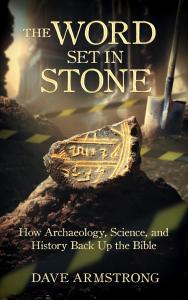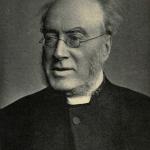This excerpt is from Chapter Twelve (“Digging Up Proofs of the Prophets”) of my book, The Word Set in Stone: How Archaeology, Science, and History Back up the Bible (Catholic Answers Press, March 15, 2023: see further book and purchase information). Bible passages: RSV.
*****
Daniel in the Lions’ Den
The famous story of Daniel in the lions’ den can be found in [Daniel] chapter 6:
Then the king [Darius] commanded, and Daniel was brought and cast into the den of lions. The king said to Daniel, “May your God, whom you serve continually, deliver you!” And a stone was brought and laid upon the mouth of the den, and the king sealed it with his own signet and with the signet of his lords, that nothing might be changed concerning Daniel. Then the king went to his palace, and spent the night fasting; no diversions were brought to him, and sleep fled from him.
Then, at break of day, the king arose and went in haste to the den of lions. When he came near to the den where Daniel was, he cried out in a tone of anguish and said to Daniel, “O Daniel, servant of the living God, has your God, whom you serve continually, been able to deliver you from the lions?” Then Daniel said to the king, “O king, live for ever! My God sent his angel and shut the lions’ mouths, and they have not hurt me, because I was found blameless before him; and also before you, O king, I have done no wrong.” Then the king was exceedingly glad, and commanded that Daniel be taken up out of the den. So Daniel was taken up out of the den, and no kind of hurt was found upon him, because he had trusted in his God (vv. 14–23).
The British Museum has an article entitled “Lion-hunting: the sport of kings.” It states,
Some of the most spectacular depictions of the hunt were found in the palace of king Ashurnasirpal II (883–859 B.C.) at the city of Nimrud (in the north of present-day Iraq).
They show the king hunting lions and wild bulls from his chariot. . . . More than 200 years later, King Ashurbanipal [r. 669–631 B.C.] revived the royal lion hunt and decorated his North Palace at the city of Nineveh (also in the north of present-day Iraq) with brilliantly carved reliefs that show his prowess as a brave hunter. . . . Although Ashurbanipal represented himself hunting animals in the wild, the hunting scenes that decorated Ashurbanipal’s palace were staged events within the game parks of the city. These were public spectacles, comparable to Roman arena games. [257]
The Joy of Museums website concurs:
The Lion Hunt of Ashurbanipal, a sequence of Assyrian palace reliefs from the North Palace at Nineveh dating from about 645 B.C., shows King Ashurbanipal hunting lions. The Assyrian “royal lion hunt” was the staged and ritualized killing by the king of lions already captured and released into an arena. [258]
The idea, then, in light of the above information, was that Assyrian kings necessarily had to keep lions in some sort of confinement (in the above instance, a “cage”) for the purpose of having spectacles of lion-hunting in their arenas (much as the Romans later did, to kill Christians for the purpose of morbid spectacle). In the Bible, 2 Samuel 23:20 and 1 Chronicles 11:22 refer to a man who “went down and slew a lion in a pit.”
The Persians followed this practice of glorifying royal lion-hunting:
There are some echoes . . . of the staged lion-hunting imagery in the Persian palaces, which displays the lion as a dangerous creature. At Persepolis, its presence is recurrent: in several buildings there are images in the Palace of Darius showing a figure fighting beasts, including lions. [259]
The argument and hypothesis, then, is that perhaps Daniel was cast into one of these places of confinement (a “den”) of lions, possibly also for the purpose of staged-spectacle hunting. And if that was indeed the case, we see that the Bible was again accurate for the umpteenth time.
FOOTNOTES
257 “Lion hunting: The sport of kings,” British Museum.
258 “Lion Hunting Scene—750 BC,” Joy of Museums.
259 Eran Almagor, “The Horse and the Lion in Achaemenid Persia: Representations of a Duality,” Arts 10(3), 41 (June 23, 2021); special issue, “Animals in Ancient Material Cultures (vol. 1)”.
***
Practical Matters: Perhaps some of my 4,200+ free online articles (the most comprehensive “one-stop” Catholic apologetics site) or fifty-one books have helped you (by God’s grace) to decide to become Catholic or to return to the Church, or better understand some doctrines and why we believe them.
Or you may believe my work is worthy to support for the purpose of apologetics and evangelism in general. If so, please seriously consider a much-needed financial contribution. I’m always in need of more funds: especially monthly support. “The laborer is worthy of his wages” (1 Tim 5:18, NKJV). 1 December 2021 was my 20th anniversary as a full-time Catholic apologist, and February 2022 marked the 25th anniversary of my blog.
PayPal donations are the easiest: just send to my email address: [email protected]. You’ll see the term “Catholic Used Book Service”, which is my old side-business. To learn about the different methods of contributing, including 100% tax deduction, etc., see my page: About Catholic Apologist Dave Armstrong / Donation Information. Thanks a million from the bottom of my heart!
***
Summary: We can’t prove that a miracle occurred with regard to Daniel & the lion’s den, but we can show that caged lions were kept for spectacle by the Babylonians & Persians.













